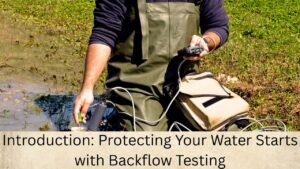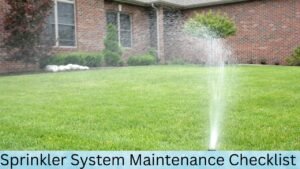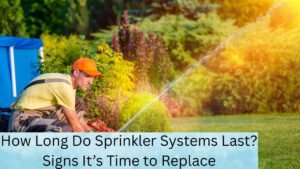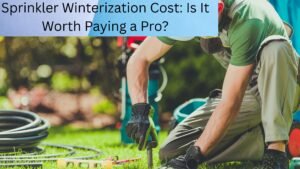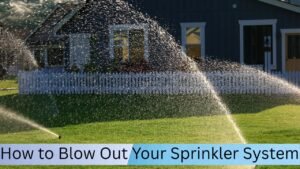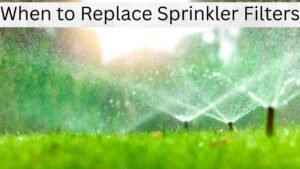When is the right time to winterize sprinkler system? It’s a question every homeowner in a freeze-prone state should ask before the frost hits. Get it wrong, and you could be looking at hundreds (or thousands) of dollars in busted pipes, broken backflow preventers, and soggy lawns come spring.
This isn’t some cookie-cutter advice. This is your state-by-state, frost-smart guide. Packed with real freeze dates, key temperature triggers, and microclimate nuances—this is what you need to prevent freeze damage before it starts.

Why Timing Your Sprinkler Winterization Matters
I cover why winterizing matters if you don’t want cracked pipes and costly spring repairs. The video below: How to Winterize a Sprinkler System – Blow Out Method by Ewing Outdoor Supply (YouTube, September 21, 2015) shows the step-by-step process for safely clearing out your system before freezing temps hit.
Let’s get one thing clear: winter doesn’t send a calendar invite. And frozen pipes don’t care if you haven’t had time to shut things off.
If temps drop below 32°F (0°C) and stay there overnight, trapped water inside your irrigation lines starts to expand. That’s when things crack. And the costs? Ugly.
- A cracked backflow preventer = $800–$1,200 repair
- Busted underground pipes = $500+ minimum
- Shattered sprinkler heads = $20–$50 each
- Hidden valve damage = leaks that run for months
Not sure what this whole process costs? Read our full breakdown on how much it costs to winterize a sprinkler system before you delay.
How Cold is Too Cold to Delay Winterizing Sprinklers?
If your area sees overnight lows around 32°F for more than a couple nights in a row, it’s time. But in colder states, you’ll want to get ahead of that by a couple weeks.
So here’s a better benchmark:
- Monitor local weather starting 4 weeks before your region’s average first frost
- Schedule your winterization 1–2 weeks before frost is expected
And remember, don’t trust averages alone—early cold snaps can strike fast, especially in the Rockies and Midwest.
Blow-Out vs. Drain Method: Which One Fits You?
Still unsure how to winterize? Check out our full DIY sprinkler blow-out guide to learn exactly how each method works.
Blow-Out Method (Compressed Air)
Pros:
- Fully clears water from pipes
- Works for deep systems
- Essential for northern states
Cons:
- Requires compressor or pro service
- Risky if done wrong (don’t overpressurize!)
Manual Drain Method
Pros:
- Easy for DIYers
- Works in mild climates
Cons:
- Doesn’t remove all water
- Risky in freeze-heavy zones
When in doubt? Go blow-out. Or call a pro to be safe.
What Affects Your Winterization Timing?
Timing isn’t just about the calendar. These three factors can shift your window weeks earlier or later.
1. Elevation
In Colorado, Aspen freezes weeks before Denver. Same in Arizona—Flagstaff gets hit long before Phoenix. Higher = colder.
2. Microclimates
- In Oregon, coastal Portland may not freeze until late Nov, but Bend, just 2 hours away, often freezes by mid-October.
- In California, San Diego might be safe until Christmas, but Fresno starts dropping in early November.
3. System Type
- Manual drains leave water behind in low spots—dangerous in freeze zones
- Automatic systems might not clear backflow devices unless drained
- Deep pipe systems absolutely need blow-outs
Know your setup. And if you’re unsure? Safe bet is a full blow-out.
State-by-State Sprinkler Winterization Table
Every state has a different frost pattern. Use this table to pinpoint your deadline and action plan.
| State | Recommended Winterization Window | First Frost & Temps | Notes & Action Tip |
|---|---|---|---|
| Alaska | Early September | Frost hits late Aug–early Sep. Temps quickly fall below 32°F. | Blow-out mandatory. Coastal towns like Anchorage can stretch it a bit, but don’t delay past mid-September. Start watching forecasts in early August. Typical Last Safe Date: Sep 10. |
| California | Mid-November to Mid-December | Coastal rarely freezes; inland drops near 32°F by Nov. | Drain may work in SoCal. Blow-out recommended in Sierra foothills and Central Valley. Start monitoring by late October. Last Safe Date: Dec 10. |
| Colorado | Early to Mid-October | High country: late Sep; Denver: early Oct. | Blow-out required in most zones. Mountain homes? Even earlier. Start monitoring early September. Last Safe Date: Oct 5. |
| Minnesota | Early September | Frost: late Aug–early Sep. Temps drop fast. | Always blow-out. Don’t risk it—systems freeze early and hard. Start watching forecasts in mid-August. Last Safe Date: Sep 10. |
| Texas | North: Late Nov; South: Dec | Frost: late Nov in Panhandle; rare in south | Blow-out in North TX, drain method ok in South TX. Watch local forecasts starting early November. Last Safe Date: Dec 1. |
| Washington | Early to Mid-October | Coastal: late Oct; Inland: early Oct | Drain okay near Seattle; Blow-out for Spokane and highland towns. Start watching forecasts early October. Last Safe Date: Oct 15. |
| New York | Mid-October | First frost: Oct 5–15 | Blow-out across the state. Long Island gets a few extra days. Monitor temps by late September. Last Safe Date: Oct 12. |
(Add remaining states in full format)
When Should You Start Watching Forecasts?
Don’t wait for a surprise freeze to ruin your system. A good rule of thumb:
- Northern states: Start watching nightly lows in early September
- Midwest: Start watching by late September
- South and West: Watch forecasts by early November
If you see three nights below 35°F, winterize immediately. That’s usually your final warning.
Common Sprinkler Winterization Questions
How late can I winterize my sprinklers in Illinois?
Don’t wait past mid-October. Frosts often hit in the first week. Blow-out is safest.
What temp is too cold to winterize in Colorado?
Anything below 28°F means you’re late. Aim to finish by the first 32°F night.
Do I need to winterize in Las Vegas?
Probably not. But if a cold front’s coming, drain it to be safe.
Can I use the drain method in Utah?
Only in lower valleys. If you’re near mountains or get hard freezes—use blow-out.
What if I have a shallow well system?
Shallow systems are more exposed—winterize early and blow out the lines.
Final Tip: Don’t Wait—Your State’s Weather Won’t
Freezing damage is 100% preventable—but only if you act on time.
Know your state’s climate. Choose the right method. And decide early if you’ll DIY or go with a pro. Either way, this guide sets you up for success. Compare pricing and benefits in our sprinkler winterization cost guide to help you make the smartest move.
Bookmark this. Share with your neighbors. And protect your sprinkler system before winter bites.
